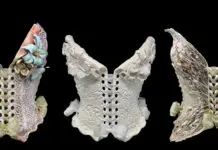Bryan Reynolds is an award-winning nature photographer whose work has appeared in National Geographic Society documentaries and high-profile magazines such as Discover. The Lexington, Okla., native will go anywhere and do anything to get the perfect shot.
Oklahoma Magazine: You’ve taken literally thousands of photos of insects, butterflies, spiders and other critters. Clearly you have a passion for this.
Bryan Reynolds: It started when I was a boy. I had a passion for insects. After seeing my aunt’s collection, I started collecting. At first it was just a cigar box and sewing pins but I eventually, through reading, found out how to properly pin and curate a museum-quality collection. I’d go out with a net, find the most beautiful specimens, catch them and kill them. I’d put them on a pinning board and spread them properly and add a label describing what it was, where I found it and the date. I took a lot of pride in it.
OM: How’d you make the move from collecting to photographing?
BR: One thing I’d neglected to do was add mothballs to my collection, which is basically pest control. Museum beetles got in there. They specialize in eating dead specimens. They destroyed my collection. I was devastated. I gave up on the idea of another collection. But my folks had a good idea. I had tons of books, magazines – anything I could grab or find about insects – and I really liked the close-up photography. So they got me a camera. Everything was manual. It was an old Minolta that used film. It was around that time that John Shaw, who was a noted nature and wildlife photographer, came out with his first book. And it was about how to photograph nature and wildlife. It became my bible. I studied that and tried all the techniques and with a lot of trial and error, started to get some pretty good photos.
OM: What inspired you to build your nonprofit, Butterflies of the World?
BR: Through my photography, I’ve been lucky enough to work with some of the experts in various fields of study, including butterflies. All of their stories are the same. I collaborated with these guys for articles. Some of these people have been studying butterflies for 50 years. They all have the same story of certain areas where they could go for 30 years and be guaranteed to find rare species in great numbers and all of a sudden, that particular area is gone. It’s a Walmart parking lot or a freeway or it’s been strip-mined or whatever. After hearing this over and over, I realized butterflies are in severe decline. They’re disappearing. They’re also a great way to show people the big picture, too. You could plug any animal in there – frogs are disappearing, mussels are disappearing. Who knows how many species we’ve killed in the rain forests? Maybe one of them could have helped cure cancer or AIDS.
OM: But you didn’t choose mussels or frogs.
BR: Well, butterflies are an excellent indicator of the quality of a habitat. If you have certain species in particular areas, that’s a good sign. If those species are not in those particular areas, then there’s something wrong. They’re kind of like the canaries in mines. You can use other animals – fresh water mussels, tiger beetles – in the same way. But the public can’t relate to those as much. Everybody knows what a butterfly is and everybody has a butterfly that visits them in their backyard. They’re common and most people like them. I don’t know anybody that just can’t stand butterflies.

























